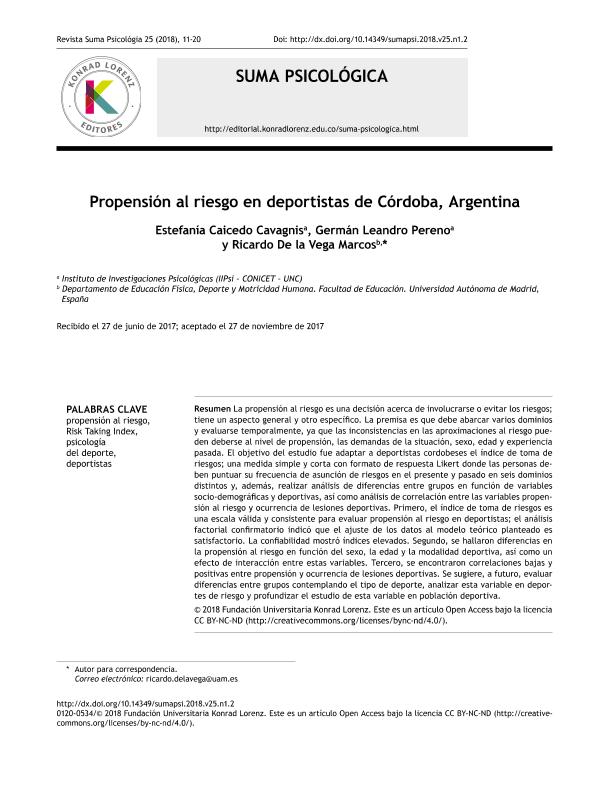Artículo
La propensión al riesgo es una decisión acerca de involucrarse o evitar los riesgos; tiene un aspecto general y otro específico. La premisa es que debe abarcar varios dominios y evaluarse temporalmente, ya que las inconsistencias en las aproximaciones al riesgo pueden deberse al nivel de propensión, las demandas de la situación, sexo, edad y experiencia pasada. El objetivo del estudio fue adaptar a deportistas cordobeses el índice de toma de riesgos; una medida simple y corta con formato de respuesta Likert donde las personas deben puntuar su frecuencia de asunción de riesgos en el presente y pasado en seis dominios distintos y, además, realizar análisis de diferencias entre grupos en función de variables socio-demográficas y deportivas, así como análisis de correlación entre las variables propensión al riesgo y ocurrencia de lesiones deportivas. Primero, el índice de toma de riesgos es una escala válida y consistente para evaluar propensión al riesgo en deportistas; el análisis factorial confirmatorio indicó que el ajuste de los datos al modelo teórico planteado es satisfactorio. La confiabilidad mostró índices elevados. Segundo, se hallaron diferencias en la propensión al riesgo en función del sexo, la edad y la modalidad deportiva, así como un efecto de interacción entre estas variables. Tercero, se encontraron correlaciones bajas y positivas entre propensión y ocurrencia de lesiones deportivas. Se sugiere, a futuro, evaluar diferencias entre grupos contemplando el tipo de deporte, analizar esta variable en deportes de riesgo y profundizar el estudio de esta variable en población deportiva. Risk propensity is a decision which entails either becoming involved in – or avoiding risks. Risk propensity has a general and specific aspect. The premise is that risk propensity has to encompass several domains and a temporal dimension. The level of propensity, situational demand, gender, age and past experience produce inconsistency in risk approaches. An instrumental study was developed to adapt the Risk Taking Index (RTI) in athletes from Córdoba, Argentina. The RTI is a simple and short measure with a Likert response format where people must rate their risk propensity in the present and past in six domains. In addition, differences between groups were performed, based on socio-demographic and sports variables, as well as correlation analysis between risk propensity and sports injuries occurrence. First, it was found that the RTI is a valid and consistent scale for assessing risk propensity in athletes. Confirmatory factor analysis indicated that the fit of the data to the theoretical model is satisfactory and reliability analysis showed high rates. Secondly, differences in risk propensity were found based on sex, age, and sports modality, as well as an interaction effect between these variables. Thirdly, small and positive associations were found between risk propensity and occurrence of both current and past sports injuries. In the future, it is suggested to evaluate differences between groups contemplating the type of sport, analiz-ing risk in risky sports and delving into the study of this variable in the sports population.
Propensión al riesgo en deportistas de Córdoba, Argentina
Título:
Risk propensity in athletes from Córdoba, Argentina
Fecha de publicación:
01/2018
Editorial:
Konrad Lorenz Editores
Revista:
Suma Psicologica
ISSN:
2145-9797
Idioma:
Español
Tipo de recurso:
Artículo publicado
Clasificación temática:
Resumen
Palabras clave:
ATHLETES
,
RISK PROPENSITY
,
RISK TAKING INDEX
,
SPORT PSYCHOLOGY
Archivos asociados
Licencia
Identificadores
Colecciones
Articulos(CCT - CORDOBA)
Articulos de CTRO.CIENTIFICO TECNOL.CONICET - CORDOBA
Articulos de CTRO.CIENTIFICO TECNOL.CONICET - CORDOBA
Articulos(CIECS)
Articulos de CENTRO DE INVESTIGACIONES Y ESTUDIO SOBRE CULTURA Y SOCIEDAD
Articulos de CENTRO DE INVESTIGACIONES Y ESTUDIO SOBRE CULTURA Y SOCIEDAD
Citación
Caicedo Cavagnis, Estefanía Elena; Pereno, German Leandro; de la Vega Marcos, Ricardo; Propensión al riesgo en deportistas de Córdoba, Argentina; Konrad Lorenz Editores; Suma Psicologica; 25; 1; 1-2018; 11-20
Compartir
Altmétricas




